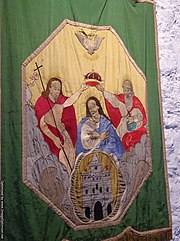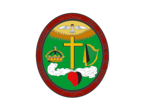This article includes a list of general references, but it lacks sufficient corresponding inline citations. (April 2009) |
Irish Catholic Confederation Comhdháil Chaitliceach na hÉireann | |||||||||
|---|---|---|---|---|---|---|---|---|---|
| 1642–1652 | |||||||||
| Motto: Hiberni unanimes pro Deo Rege et Patria (Latin) Éireannaigh aontaithe le Dia, rí agus tír (Irish) "Irishmen united for God, king and country" | |||||||||
| Capital | Kilkenny | ||||||||
| Common languages | Irish, English | ||||||||
| Religion | Roman Catholic | ||||||||
| Government | Confederal constitutional monarchy | ||||||||
| King | |||||||||
• 1641–1649 | Charles I | ||||||||
• 1649–1653 | Charles II | ||||||||
| Legislature | General Assembly | ||||||||
| Historical era | Irish Confederate Wars | ||||||||
| 1641 | |||||||||
• Established | 1642 | ||||||||
| 1652 | |||||||||
| |||||||||

Confederate Ireland, also referred to as the Irish Catholic Confederation, was a period of Irish Catholic self-government between 1642 and 1652, during the Eleven Years' War. Formed by Catholic aristocrats, landed gentry, clergy and military leaders after the Irish Rebellion of 1641, the Confederates controlled up to two-thirds of Ireland from their base in Kilkenny; hence it is sometimes called the "Confederation of Kilkenny".
The Confederates included Catholics of Gaelic and Anglo-Norman descent. They wanted an end to anti-Catholic discrimination within the Kingdom of Ireland and greater Irish self-governance; many also wanted to roll back the plantations of Ireland. Most Confederates professed loyalty to Charles I of England in the belief they could reach a lasting settlement in return for helping defeat his opponents in the Wars of the Three Kingdoms.[1] Its institutions included a legislative body known as the General Assembly, an executive or Supreme Council, and a military. It minted coins, levied taxes and set up a printing press.[1] Confederate ambassadors were appointed and recognised in France, Spain and the Papal States,[1] who supplied them with money and weapons.
At various times, Confederate armies fought Royalists, Parliamentarians, Ulster Protestant militia and Scots Covenanters; these controlled the Pale, parts of eastern and northern Ulster, and the region around Cork. Charles authorised secret negotiations which in September 1643 resulted in a Confederate–Royalist ceasefire and led to further talks, most of which proved unsuccessful. In 1644, a Confederate military expedition landed in Scotland to help Royalists there. The Confederates continued to fight the Parliamentarians in Ireland, and decisively defeated the Covenanter army in the Battle of Benburb.
In 1647, the Confederates suffered a string of defeats at Dungan's Hill, Cashel and Knocknanuss. This prompted them to make an agreement with the Royalists, leading to internal divisions which hampered their ability to resist a Parliamentarian invasion. In August 1649, a large English Parliamentarian army, led by Oliver Cromwell, invaded Ireland. By May 1652 it had defeated the Confederate–Royalist alliance, although Confederate soldiers continued a guerrilla warfare campaign for a further year.
- ^ a b c The Confederate Assembly of Kilkenny Archived 28 October 2020 at the Wayback Machine. British Civil Wars Project.

